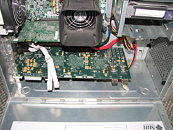- Joined
- Jul 8, 2005
- Messages
- 3,113 (0.43/day)
- Location
- Victoria, BC, Canada
| System Name | Corsair 2000D Silent Gaming Rig |
|---|---|
| Processor | Intel Core i5-14600K |
| Motherboard | ASUS ROG Strix Z790-i Gaming Wifi |
| Cooling | Corsair iCUE H150i Black |
| Memory | Corsair 64 GB 6000 MHz DDR5 |
| Video Card(s) | Gainward GeForce RTX 4080 Phoenix GS |
| Storage | TeamGroup 1TB NVMe SSD |
| Display(s) | Gigabyte 32" M32U |
| Case | Corsair 2000D |
| Power Supply | Corsair 850 W SFX |
| Mouse | Logitech MX |
| Keyboard | Sharkoon PureWriter TKL |
COLLEGE PARK, Md.-A prototype of what may be the next generation of personal computers has been developed by researchers in the University of Maryland's A. James Clark School of Engineering. Capable of computing speeds 100 times faster than current desktops, the technology is based on parallel processing on a single chip.
Parallel processing is an approach that allows the computer to perform many different tasks simultaneously, a sharp contrast to the serial approach employed by conventional desktop computers. The prototype developed by Uzi Vishkin and his Clark School colleagues uses a circuit board about the size of a license plate on which they have mounted 64 parallel processors. To control those processors, they have developed the crucial parallel computer organization that allows the processors to work together and make programming practical and simple for software developers.

Parallel processing on a massive scale, based on interconnecting numerous chips, has been used for years to create supercomputers. However, its application to desktop systems has been a challenge because of severe programming complexities. The Clark School team found a way to use single chip parallel processing technology to change that.
Vishkin, a professor in the Clark School's electrical and computer engineering department and the university's Institute for Advanced Computer Studies, explains the advantage of parallel processing like this:
"Suppose you hire one person to clean your home, and it takes five hours, or 300 minutes, for the person to perform each task, one after the other," Vishkin said. "That's analogous to the current serial processing method. Now imagine that you have 100 cleaning people who can work on your home at the same time! That's the parallel processing method.
"The 'software' challenge is: Can you manage all the different tasks and workers so that the job is completed in 3 minutes instead of 300?" Vishkin continued. "Our algorithms make that feasible for general-purpose computing tasks for the first time."
Vishkin and his team are now demonstrating their technology, which in future devices could include 1,000 processors on a chip the size of a finger nail, to government and industry groups. To show how easy it is to program, Vishkin is also providing access to the prototype to students at Montgomery Blair High School in Montgomery County, Md.
View at TechPowerUp Main Site
Parallel processing is an approach that allows the computer to perform many different tasks simultaneously, a sharp contrast to the serial approach employed by conventional desktop computers. The prototype developed by Uzi Vishkin and his Clark School colleagues uses a circuit board about the size of a license plate on which they have mounted 64 parallel processors. To control those processors, they have developed the crucial parallel computer organization that allows the processors to work together and make programming practical and simple for software developers.

Parallel processing on a massive scale, based on interconnecting numerous chips, has been used for years to create supercomputers. However, its application to desktop systems has been a challenge because of severe programming complexities. The Clark School team found a way to use single chip parallel processing technology to change that.
Vishkin, a professor in the Clark School's electrical and computer engineering department and the university's Institute for Advanced Computer Studies, explains the advantage of parallel processing like this:
"Suppose you hire one person to clean your home, and it takes five hours, or 300 minutes, for the person to perform each task, one after the other," Vishkin said. "That's analogous to the current serial processing method. Now imagine that you have 100 cleaning people who can work on your home at the same time! That's the parallel processing method.
"The 'software' challenge is: Can you manage all the different tasks and workers so that the job is completed in 3 minutes instead of 300?" Vishkin continued. "Our algorithms make that feasible for general-purpose computing tasks for the first time."
Vishkin and his team are now demonstrating their technology, which in future devices could include 1,000 processors on a chip the size of a finger nail, to government and industry groups. To show how easy it is to program, Vishkin is also providing access to the prototype to students at Montgomery Blair High School in Montgomery County, Md.
View at TechPowerUp Main Site





 The 8800GTSx1000
The 8800GTSx1000 



